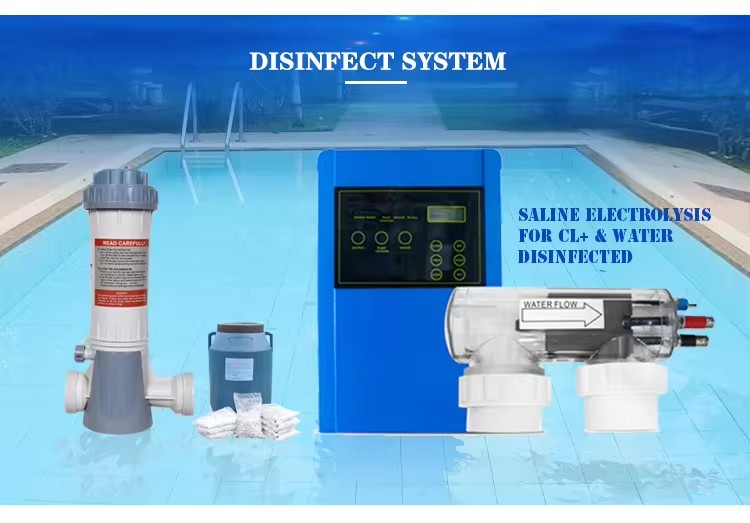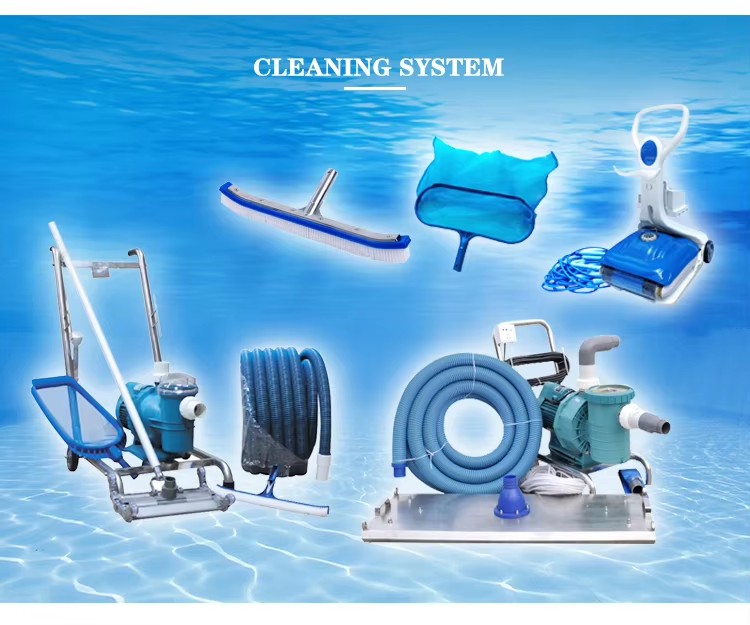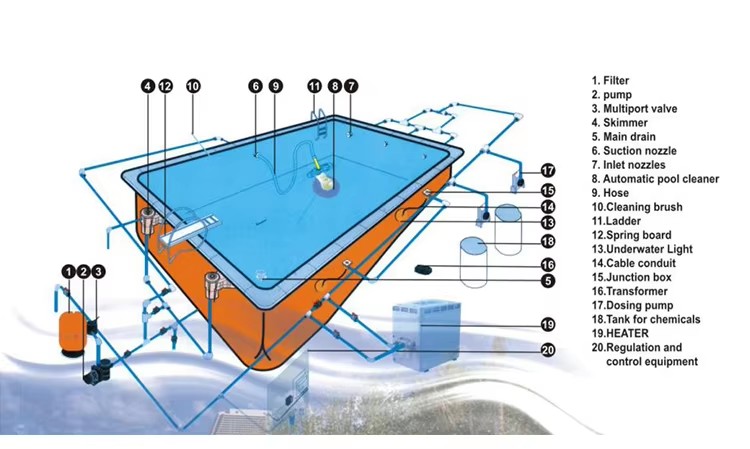
Swimming pool equipment includes a variety of devices and systems essential for the operation, maintenance, safety, and enjoyment of a swimming pool. Here’s a breakdown of the key categories and examples of swimming pool equipment:
1. Filtration Systems
These are essential for keeping the pool water clean and free of debris.
Pool Filters: Filters remove dirt, debris, and small particles from the water. Types include: Sand Filters, Cartridge Filters, Diatomaceous Earth (DE) Filters
Pool Pumps: Circulates water through the filtration system, ensuring consistent water flow and filtration.

2. Water Circulation Equipment
Ensures proper water flow and distribution of chemicals.
Pool Skimmers: Surface skimmers remove floating debris like leaves and insects from the water’s surface.
Main Drains: Located at the bottom of the pool, they help in circulating water and removing debris from the pool floor.
Return Jets: These return the filtered water back into the pool, helping in circulation.

3. Sanitization Systems
These systems help maintain water hygiene and safety by controlling bacteria and algae growth.
Chlorinators: Automatically add chlorine to the pool water to maintain proper sanitation levels.
Saltwater Chlorine Generators: Convert salt into chlorine for pools using saltwater systems.
UV and Ozone Systems: Use ultraviolet light or ozone to kill bacteria and viruses, reducing the need for chemical sanitizers.

4. Heating Systems
Provide temperature control, ensuring the pool water is comfortable.
Pool Heaters: Use gas, electricity, or solar energy to heat the pool water.
Heat Pumps: Extract heat from the air to warm the pool water, more energy-efficient than traditional heaters.
Solar Covers/Blankets: Passive heating by capturing solar energy to warm the pool and reduce heat loss.

5. Cleaning Equipment
Helps in maintaining the cleanliness and appearance of the pool.
Pool Vacuums: Used to clean the pool floor and walls. Can be manual, automatic (robotic), or suction-side.
Pool Brushes: Used for scrubbing the pool walls and floor to remove algae and dirt.
Leaf Nets/Skimmers: Handheld tools used to remove leaves and debris from the water’s surface.

6. Safety Equipment
Ensures the safety of swimmers and compliance with safety regulations.
Pool Covers: Prevents debris from entering the pool and provides safety by covering the water surface when not in use.
Pool Alarms: Detects unauthorized entry into the pool area or water disturbances.
Fencing and Gates: Essential for preventing unsupervised access to the pool, especially for children and pets.
7. Lighting and Aesthetic Features
Enhances the visual appeal and usability of the pool, especially at night.
Pool Lights: Underwater lighting for safety and aesthetics, available in LED, halogen, and fiber optic options.
Water Features: Includes waterfalls, fountains, and jets that add aesthetic value and enjoyment.
Pool Decking and Surrounds: The area around the pool, which can include materials like concrete, pavers, or wood, and often includes decorative elements.
8. Automation and Control Systems
Allows for easier management of pool operations.
Automated Pool Controllers: Control multiple aspects of the pool, including pumps, heaters, lights, and sanitization systems.
Timers: Automate the operation of pumps, lights, and other equipment to optimize energy usage.
9. Chemical Feeders and Test Kits
Ensure proper chemical balance in the pool water.
Chemical Feeders: Automatically dispense chemicals into the pool water.
Test Kits and Meters: Used to test and monitor the chemical balance of the pool, including pH, chlorine levels, and alkalinity.
10. Additional Accessories
These add convenience, safety, and comfort.
Pool Ladders and Steps: Provide safe access in and out of the pool.
Diving Boards and Slides: Fun accessories that need to be installed and used with safety in mind.
Pool Floats and Toys: For recreational purposes.

Conclusion
Fenlin swimming pool equipment encompasses a broad range of devices and systems, each playing a crucial role in the operation, maintenance, safety, and enjoyment of the pool. When selecting equipment, consider factors such as pool size, usage frequency, climate, and budget to ensure you choose the right components for your specific needs.


















